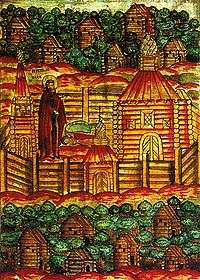Nilus of Sora
| Nil Sorsky | |
|---|---|
 | |
| Born |
1443 Moscow |
| Died | May 7, 1508 |
| Venerated in | Eastern Orthodoxy, Eastern Catholicism |
| Feast | May 7 |
Nil Sorsky (Russian: Нил Сорский, also Nilus of Sora and Nil Sorski; birth name: Nikolai Maikov (Russian: Николай Майков) (c. 1433–1508) became a leader of a tendency in the medieval Russian Orthodox Church known as the "Non-possessors" which opposed ecclesiastic landownership.[1] The Russian Orthodox Church venerates Nil Sorsky as a saint, marking his feast day on the anniversary of his repose on May 7.[2]
Early life
Nilus of Sora, a great ascetic of the Russian Church, was descended from the Maikov nobility.[3] Before becoming a monk, Nil Sorsky worked as a scribe and was engaged in book copying. Later in his life, he took monastic vows at the Kirillo-Belozersky Monastery, which had been known for its hostile stance towards monastic landownership. The founder of the monastery – Saint Kirill of Beloozero – was himself known for rejecting villages that had been offered to him by devout nobles.
Kirill’s followers adopted his ways and would later become known as the startsy from out the Volga with Nil Sorsky as their leader. Soon, he went on a journey to the Holy Land and visited Palestine, Constantinople, and Mount Athos, acquainting himself with a mystical doctrine of Hesychasm and reading patristic literature. Upon his return to Russia (between 1473 and 1489), Nil Sorsky founded a cloister on the Sora River (hence, Nil Sorsky, or Nil of Sora) not far from the Kirillo-Belozersky Monastery, where he would settle down with his followers. He wrote extensively.[4]
The Novgorod heresy affair
Nil Sorsky was involved in the Novgorod heresy affair (see Sect of Skhariya the Jew for details), which had stirred a lot of minds in Russia at that time. It appears that Sorsky and his closest associate Paisiy Yaroslavov were much more tolerant towards the heretics than most of the Russian clergy, led by Gennady (Archbishop of Novgorod) and Joseph Volotsky.
In 1489, Archbishop Gennady embarked on the path of fighting the heretics and asked Archbishop of Rostov to consult with the elders Nil Sorsky and Paisiy Yaroslavov (who had been living in his eparchy) and seek their assistance in this matter. Historical accounts of that period do not shed any light on the outcome of these "negotiations", but from that time on there seems to have been no interaction between Sorsky and Yaroslavov on one side and Gennady and Joseph Volotsky on the other.
The two elders, however, did not treat heresy with indifference. They were both present at the Synod of 1490, which dealt with heresy, and exerted their influence upon its final decision. Initially, the clergy unanimously spoke in support of burning all the heretics at the stake. At the conclusion of the synod, however, only a few priests were condemned and then defrocked without being executed. Later in the decade, however, several heretics were burned in both Novgorod and Moscow.[5]
Teaching and influence
In his teachings, he developed mystical and ascetical ideas along the lines of Gregory Sinaite's hesychasm, asking the believers to concentrate on their inner world and personal emotional experiences of faith as means for achieving unity with God. Nil Sorsky demanded that monks participate in productive labor and spoke in support of monastic reforms on a basis of a secluded and modest lifestyle.
Nil Sorsky dedicated his efforts towards fighting against monastic landownership rights at the Synod of 1503 in Moscow. There, he raised a question about monastic estates, which comprised about one third of the territory of the whole Russian state at that time and which, in his view, had been responsible for demoralization of the Russian monastic communities. Nil Sorsky was supported by the elders of the Kirillo-Belozersky Monastery and his disciple Vassian Patrikeyev. Although he spoke in favor of Ivan III’s policy of secularization of monastic lands, Sorsky did not live long enough to see the end of this struggle. Patrikeyev and Artemius of the Trinity were Nil Sorsky’s successors.
References
- ↑ On Nil Sorsky, see David M. Goldfrank, "Recentering Nil Sorskii: The Evidence from the Sources," Russian Review 66, No. 3 (2007): 359–376.
- ↑ (Greek) Ὁ Ὅσιος Νεῖλος ἐκ Ρωσίας. 7 Μαΐου. ΜΕΓΑΣ ΣΥΝΑΞΑΡΙΣΤΗΣ.
- ↑ "Repose of the Venerable Nilus the Abbot of Sora", Orthodox Church in America
- ↑ Nil Sorsky: The Complete Writings. George Maloney, ed. and trans.(Mahwah, NJ: Paulist Press, 2003).
- ↑ David M Goldfrank, "Burn, Baby, Burn: Popular Culture and Heresy in Late Medieval Russia," The Journal of Popular Culture 31, no. 4 (1998): 17–32; Andrei Pliguzov, "Archbishop Gennadii and the Heresy of the 'Judaizers'" Harvard Ukrainian Studies 16(3/4) December 1992: 269-288; George Vernadsky, "The Heresy of the Judaizers and the Policies of Ivan III of Moscow," Speculum, Vol. 8, No. 4 (Oct., 1933): 436-454.
External links
- Webpage on Nil Sorsky
- Saint Nil Sorsky in French, with rich iconography & hymnography (saint Nil de la Sora, avec riche iconographie & hymnographie)